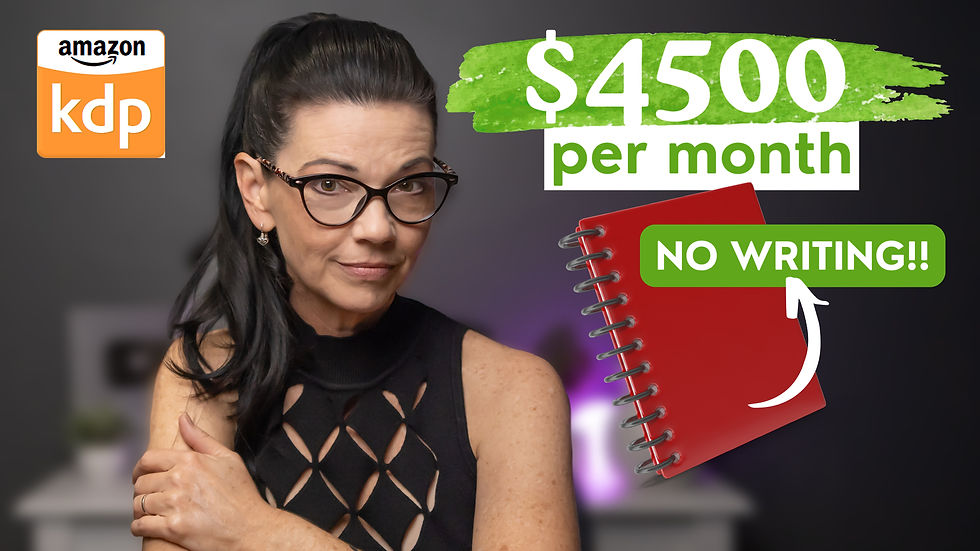In this blog post, I'll walk you through the entire process of setting up and publishing medium content books, like journals, planners, and notebooks, on Amazon KDP. I recently discovered a profitable book niche that’s starting to generate sales, and I’m sharing every detail so you can get started too. This is a comprehensive guide that covers everything from trim sizes and bleed settings to keyword research and book formatting using BookBolt.

If you're following along from my YouTube video, feel free to jump back and forth using the timeline provided. This guide is also written out step-by-step here, so you can refer back at any time.
1. Understanding Key Terms: Trim Size, Bleed, and Margins
Before diving in, it’s crucial to understand a few key terms:
Trim Size: The final width and height of your book after it’s been printed and trimmed. Common sizes include 6” x 9” for journals or 8.5” x 11” for workbooks.
Bleed: Extends images or background colors beyond the trim size to avoid white edges when the book is trimmed.
Margins: The space between your content and the edges of the page. Keep all important content within the margins to prevent it from being cut off during printing.
2. Choosing the Right Niche
When I first researched this niche, I found “sermon notes journals” using BookBolt. The results were promising, with creators consistently making sales every month. While these books may not be blockbusters, they provide steady passive income month after month.
How to Do Your Own Research:
Start with broad keywords in BookBolt, like “sermon notes.”
Analyze sales data and competition using tools like the KDP Spy extension.
Check estimated monthly revenue and sales to ensure the niche is profitable.
3. Setting Up Your Project in BookBolt
Now that you’ve identified your niche, let’s move on to creating your book:
Open BookBolt and navigate to “Create and Studio.”
Start a New Project and select “paperback” as the format.
Choose your trim size (I recommend 6” x 9” for this type of journal).
Set the interior to black and white on white paper. For this example, I opted for 150 pages.
Select “No Bleed” if your pages won’t have images or color extending to the edges.
Click “Create Project” to begin designing your book.
4. Designing the Interior Pages
In BookBolt, you can design each page of your book. Here’s how I did it:
Introductory Page: I customized the first page to give the book a personal touch.
Using Templates: Navigate to the template section (the puzzle piece icon). For a sermon notes journal, I alternated between different prayer journal templates.
Alternating Page Layouts: I placed a note-taking template on every other page to give users a mix of structured notes and freestyle writing options.
5. Adding Page Numbers and Finishing Touches
To enhance your book’s professionalism:
Go to the templates section and select a blank page with a page number.
Adjust the font size, position, and style of the page number to your preference.
Add any final design elements, like quotes or scripture verses, on pages where appropriate.
6. Designing the Book Cover
Your cover is crucial for catching attention. Here’s how I created mine:
Search for Free Images: In BookBolt, use Pixabay to find high-quality watercolor images.
Set Up Bleed Areas: Ensure your images extend beyond the bleed zone to avoid white edges.
Customizing the Back Cover: Add a sample page or preview of your book’s interior to the back cover to help readers know what they’re buying.
Align Colors and Fonts: Use the eyedropper tool to match your design elements and keep the look consistent.
7. Exporting and Uploading to KDP
After you’ve finished your design, follow these steps to upload your book to Amazon KDP:
Export the Manuscript: Download your interior as a PDF from BookBolt.
Set Up Your KDP Account: Create a new paperback project and fill in your book’s title, subtitle, and description. Use tools like ChatGPT to generate a compelling description.
Choose Categories and Keywords: Research relevant keywords and categories in BookBolt and enter them into KDP to optimize discoverability.
Upload the Files: Upload both your interior PDF and the cover design.
8. Reviewing and Publishing Your Book
Before publishing, use KDP’s previewer to check for any errors:
Launch the Previewer: Ensure your design aligns with KDP’s guidelines, including margin and trim areas.
Fix Any Errors: If necessary, go back to BookBolt, adjust your design, and re-export the files.
Set Pricing: Decide on your book’s price based on your profit margin goals. For example, I aim to profit around $0.95 to $1.10 per book.
Submit for Review: Once everything looks good, submit your book for approval. You’ll be notified via email once it’s live.
9. Promoting Your Book
After your book is live, start promoting it using these strategies:
Use targeted keywords in your listing to improve search visibility.
Share your book on social media and in relevant online communities.
Consider running Amazon ads if you’re aiming to scale up sales quickly.
Conclusion
Publishing medium content books on Amazon KDP can be a highly profitable venture if done right. By following this guide, you’ll be well on your way to creating and launching books that sell consistently month after month. Take your time with each step, and before you know it, you’ll have your own collection of books generating passive income.
If you’re watching my video, remember to refer back to this blog post as you work on your projects. Good luck, and happy publishing!
Comments